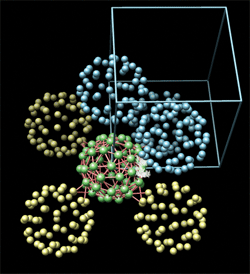 |
Dragnea has constructed artificial viruses by embedding negatively charged gold nanoparticles inside viral capsids by exploiting their attraction to the positively charged proteins lining the capsids. This mimics the interaction between “anionic genetic contents” (RNA and DNA) and those same positively charged proteins in real viruses. He has also encased fluorescent quantum dots of cadmium selenide crystals in a shell of zinc sulfide, which he then used to track how long it took for a particular virus to travel across a cell membrane.
The March Meeting session featured new research using cowpea chlorotic mottle virus (CCMV) that specifically infects the cowpea plant, more commonly known as the black-eyed pea. According to UCLA’s Charles Knobler, CCMV is a favorite choice for physical virologists because it is so evolutionarily well-designed for self-assembly that one can literally break the viruses into their constituent parts–purified viral RNA and capsid proteins–mix them together in vitro in a solution at just the right pH and ionic strength, and the mixture will spontaneously assemble into infectious particles.
Knobler is investigating what determines the size of a virus, which he believes to be a combination of polymer length and capsid size. Furthermore, he has found that it is possible to manipulate the length of protein building blocks in the CCMV and the size of the capsid in such a way as to use virus proteins to make nonbiological particles that not only contain foreign molecules, but also that conform to a specific intended structure, such as multishell structures, tubes and sheets.
Adam Zlotnick and his colleagues at the University of Oklahoma Health Sciences Center can manipulate the CCMV coat protein in such a way as to redirect its self-assembly to produce tubular structures. A major focus of Zlotnick’s lab is to understand the biophysics of virus capsid assembly.
“Capsid assembly and disassembly are salient events in the virus lifecycle, yet they are poorly understood and have not been exploited in developing antiviral therapeutics,” he said. Viral capsids serve to contain and protect the viral nucleic acid, and may also serve as a delivery mechanism and as a metabolic compartment. The CCMV is a spherical virus, so its capsid is assembled from multiples of 60 protein subunits, arranged into a soccer-ball shape (“icosahedral symmetry”).
“Knowing the structure of a virus gives us a snapshot, but add the knowledge about the kinetic process of assembly, and we have a much more complete picture” of how a virus works, according to Zlotnick, who has devised dynamic models of the self-assembly process that match well with experimental observations, “Experimentally, we have found that capsids are based on a network of extremely weak interactions,” he said. Far from being static structures, viruses are “very dynamic molecule machines.”
Because the interactions are weak, it is possible to interrupt the assembly process to generate tubular structures in addition to spheres–or even keep the virus from forming completely in the first place. The fact that it’s possible to disrupt and manipulate the process bodes well for the bottom-up production of manmade nanostructures via self-assembly for any number of applications, including the development of new antiviral drugs.
Another March Meeting session focused on panic reactions and the spread of global disease. Researchers from the Max Planck Institute for Dynamics and Self-Organization recognized that human beings will “change their dispersal characteristics” in response to local infections to avoid becoming infected themselves. The researchers found that “the individual rationale of avoiding an epidemic wave... actually facilitates epidemic spread”–at least in one of their models. A more fully developed dynamical model showed the same effect, but also “an increased extinction probability of the epidemic as a function of increasing dispersal response.”
It is difficult to model the dynamics of epidemics because there are so many unpredictable variables. Scientists would like to have a clearer picture of human mobility patterns–preferably one that can be universally applied. Researchers at Northeastern University and Notre Dame University have analyzed cell phone usage to demonstrate that human mobility can be described by the same universal pattern, regardless of what our individual travel habits may be.
These patterns could be useful in urban planning, traffic forecasting, and of course, the spread of diseases and viruses. The latter would include the possibility of cell phone software viruses, in which malevolent code could be transmitted either via text messaging or through Bluetooth connections between devices. Each transmission pathway would require different countermeasures, since text message viruses, like email, would spread through social networks rather than the physical location of the actual cell phones, whereas a Bluetooth-specific virus would spread among cell phones in close proximity.
©1995 - 2024, AMERICAN PHYSICAL SOCIETY
APS encourages the redistribution of the materials included in this newspaper provided that attribution to the source is noted and the materials are not truncated or changed.
Contributing Editor: Jennifer Ouellette
Staff Writer: Ernie Tretkoff
May 2008 (Volume 17, Number 5)
Articles in this Issue

